Masochism of the Margins:
An Interview with Craig Baldwin
By Steve Polta
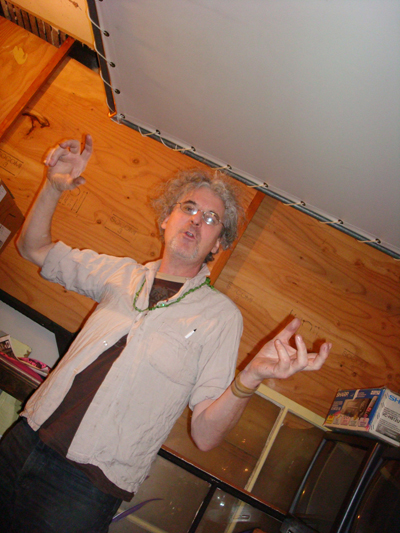
Craig Baldwin in his studio in San Francisco / Photo: Steve Polta
The legendary West Coast filmmaker Craig Baldwin is a whirlwind force of infectious creative energy. His extreme take on the found footage film genre confounds narrative, documentary, and avant-garde boundaries, proposing entirely new formulae for the intersections of form and content, audience reception and media critique. His long running curatorial project–Other Cinema, running weekly in San Francisco, thirty-six weeks a year–draws on a similar collage aesthetic. For over twenty years, Other Cinema programs have delivered to Bay Area audiences insane amalgams of underground cinema, genre film, media and community activism, performance and sound art, and unique and astounding lost-and-found orphan works from Baldwin’s infamous film/video archive as well as hosting a dizzying array of artists, curators, community activists, conspiracy freaks, and other indescribable and wonderful wackos.
Arguably as significant a cultural contribution as his film work, the history of Other Cinema has been largely undocumented. The interview appearing here is excerpted from an unpublished oral history that traces the origins of Baldwin’s curatorial work and the relationship between his film work and this area of activity. It is part of San Francisco Cinematheque’s ongoing project to collect and preserve first-person accounts of Bay Area media arts history, spearheaded by Steve Polta. A student of Baldwin’s in 1995, Polta has been a participant in the Other Cinema project continuously since January 1996 and has contributed to the production of Baldwin’s Spectres of the Spectrum (1999) and Mock Up on Mu (2008).
The original interview was conducted on September 30, 2007 at Artistsʼ Television Access (ATA) in San Francisco. [1]
* * *
SP: Let’s talk about your time in Davis, California. What were you doing there? Were you in school?
CB: Around 1970-72, I had somehow been turned on to collecting, which eventually led to the “Industrial Amok” series. [2] I left Davis in ʼ72 or ʻ73–
SP: Did you graduate from UC Davis?
CB: I didn’t. I graduated from San Francisco State University. I left school more than once, to travel around the world. I actually went to South America at that time. The point is, before I left Davis, I had already kind of moved into film. They didn’t have a film department per se, but they had a film class, taught by Mike Henderson.
At the time, I was making Super 8 films. But I was also interested in the idea of working with found stuff. Back then, if you bought films X, Y, and Z from Blackhawk, they would throw in a sampler of their other stuff just to get you interested in buying more. This was before video. I bought the sampler, nice clips from this and that, and I didn’t have to watch the whole films. Just great clips from comedies, documentaries, early cinema. I folded all of that in and made a movie out of it. In fact I did a performance with it.
SP: What was it?
CB: I can’t remember the name of the performance. But I was running around, casting my shadows and there was film projected on me and I did some action.
SP: And this was at Davis?
CB: Yeah. It sure was. I was also in the theatre department. At the time some of the film classes were in the theatre department, and some were in the English department. It didn’t make any difference to me but I was mostly in the theatre department, because I was in plays and studying about theatre, which I always had an interest in. I wasn’t really interested in film until I got a Super 8 camera. This isn’t related to programming, but my production overlapped with my programming once I got into archival stuff.
SP: You talk about the drive to collect. Where did that interest come from?
CB: I donʼt know how I got turned on to it. I saw a catalog somewhere. The films are rare now but they weren’t then. I used to have boxes and boxes and boxes of them. Now I probably have one box of them. But I used to just pour through that stuff. I literally just poured through it.
SP: You said you were making Super 8 films around that time. What sort of films were you making?
CB: Well, there was one film where I folded in the Blackhawk sampler. Early on it occurred to me that that was something I could do.
SP: Had you seen films that did that?
CB: I can’t say I remember seeing a found footage film at that time. When I was in high school I used to go to midnight movies where I saw some early underground films. That made a tremendous impression on me.
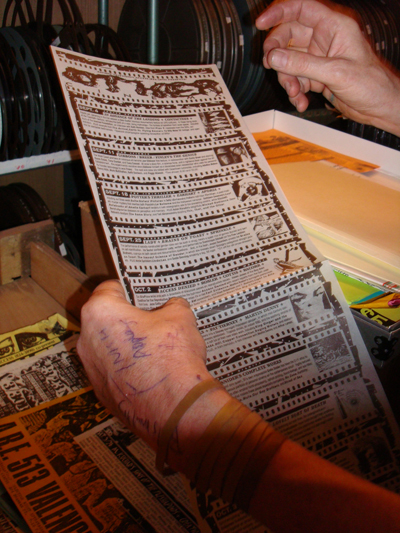
Baldwin examines an Other Cinema calendar / Photo: Steve Polta
SP: Where was this?
CB: It was called the Towne Theatre. It was right next to American River College.
SP: This was in Sacramento?
CB: Yes. Carmichael, my suburb. The theatre was probably for the benefit of the junior college students, not that it was a real active student ghetto or anything like that. But it was way in the suburbs and not downtown.
SP: What sort of programs were you seeing?
CB: Insanely brilliant straight up American underground of the ʻ60s. George Kuchar, Robert Nelson, Christopher MacLaine–
SP: So that made a big impression on you.
CB: Oh, it totally blew my mind. Just absolutely changed my life. That was my idea of fun. Most people in high school didn’t go to midnight movies; it was too beatnik. It wasn’t exactly a football game. It was like poetry, people wearing turtlenecks and all that kind of stuff. I was totally into that.
SP: You were totally into what?
CB: Beatnik-ism! You know, I was like Maynard Krebs. [Maynard G. Krebs was a “beatnik” character, played by Bob Denver, on the television program The Many Loves of Dobie Gillis, which aired 1959–1963.] I was totally into the whole image of a Beatnik. I dug it. Anyway, I canʼt say for sure if I saw a found footage film at that time. I might have. You could see them anywhere. You could watch TV commercials by the ʻ60s.
SP: Iʼm still curious where it came together for you.
CB: I canʼt say; it wasnʼt like a thunder strike moment. A lot of conditions lined up. An explosion of underground film in the ‘60s–that was coming of age here. There was also a downtown cinema in Sacramento called the Marvel Arts Cinema. Keep in mind, I was middle class. I had a Super 8 camera. I ended up going to the University of California.
SP: That was at Davis?
CB: Yeah. Davis and Santa Barbara, too.
SP: So you went to Davis and then you went to Santa Barbara.
CB: Yeah. When I went to Santa Barbara, same thing, the first fuckin’ fall. I lived in the dorms. Well, what do you do at night? You get out of your dorm room. You certainly don’t waste any time doing homework. Iʼd go to the movies on campus. Half the time it would be free for the students.
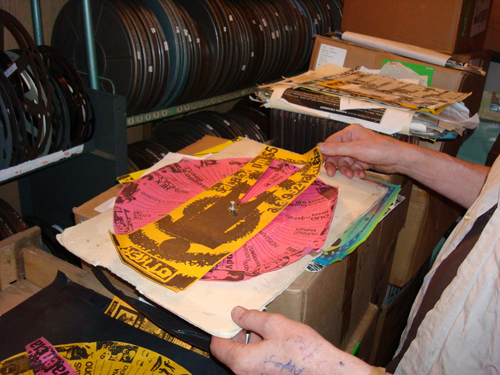
Baldwin examines an Other Cinema calendar–which features a spinning wheel!
Photo: Steve Polta
SP: And what did you see then?
CB: I will never forget the first movie. It was by Peter Watkins, the one where the Nuclear war is about to happen. I just sat through the whole thing without moving. I went to the early show, then I just sat and waited for the next show to start and saw it again. I was so bowled over. The War Game! [1965] by Peter Watkins. It was probably his most famous film. The other one was about the student strike at San Francisco State. It’s also a very famous film. It’s always talked about with the early ʻ60s radical newsreel stuff. Those are just two titles off the top of my head. In other words, it wasnʼt the Bergmans and the Pasolinis. For me it was just going down to some hall. It was, like, below theatrical level, you know, just a 16mm projector.
SP: What else were you involved with back then? You werenʼt just passively watching movies and geeking out on them.
CB: No. I was into political activism. I was always politically active. Now Iʼve become more interested in point-of-view, personal idiosyncrasies, obsessions, auteur style.
SP: So you think youʼre more interested in that now than you were back then?
CB: Oh yeah, sure. It was all about content then. Not that I have a simple definition that would define, distinguish, and divide content from the other issues. What Iʼm saying is, we were interested in looking at any film on South Africa. Now it’s more about nuance, depth, and subtleties among shorter films.
SP: Is that how you think about your programming now?
CB: One of the ways I think about it.
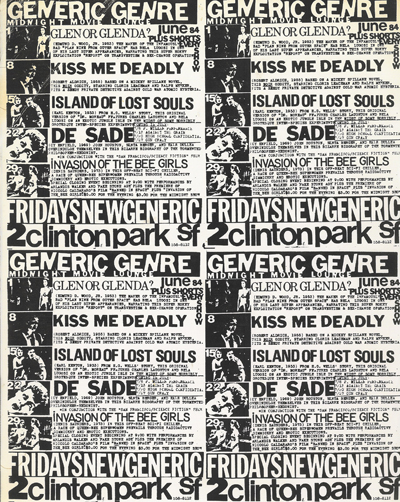
Screening poster for Generic Genre, Midnight Movie Lounge, June 1984.
Courtesy of Steve Polta and San Francisco Cinematheque.
SP: Tell me more about the difference between then and now.
CB: The idea then was that everyone was pissed off about South Africa. So we created events where we could focus and maybe learn something. Everybody would eat it up, you know, like a forty or fifty minute film, with big color images. That would be the show. It was about finding a way forward and raising consciousness, getting excited and satisfying our curiosity.
Now it has to do more with teasing people through and opening up spaces. More finesse, more nuance and breaking it down, not a huge chunky thing. I wouldnʼt be drawn towards something like that anymore. I would just leave that to television now.
SP: So has the landscape changed? Did you feel then that nobody else was showing films like that?
CB: There was a place called Le Peña in the East Bay; they would show films like that. They were a big influence on me. I only went there a couple times, but I thought their programming was great. But thatʼs all they really do: political. I wanted to do peoples’ culture: joyous Yippie stuff, revolutionary but with a sense of humor.
Karl Cohen was another huge influence on me. I still rent from him all the time. Karl had a great series at the Intersection [Intersection for the Arts]. He would show a mix of cartoons–he was always into cartoons and Academy Award winners. That wasnʼt my thing, but heʼd have an art film in there, like Simon of the Desert [Luis Buñuel, 1965]. I just loved that! He might show Simon of the Desert with a half hour of musical trailers–Nicholas Brothers doing tap dances and weird trailers and cigarette commercials, and a short here and there, and cult animations: more variety and circus-like. The way Karl was programming really made a deep impression on me.
I got a lot of my films from Karl: short things and little novelty items. He had an Alice Cooper film, which, you know, Iʼd go nuts for. Or heʼd have a film of a magician performing or something. He has a catalog, which is not bad at all. He had [Jean] Genetʼs The Balcony [directed by Joseph Strick, 1963]—which is a great film. I used to love that film and no ever talks about it.
The [San Francisco] Cinematheque never seemed to work with Karl that much, probably because his prints were pretty fucked up. But like the Em Gee films, [3] I couldnʼt get enough of them. I just thought, this is totally cool! This is made for microcinemas, because theyʼre kind of a micro-distributor.
A lot of the political films I probably got from Newsreel [Newsreel is a film distributor]. They had a South African section, and there was an El Salvador film and video place, believe it or not, right next door. Right here [i.e. on Valencia Street in San Francisco, near the interview location].
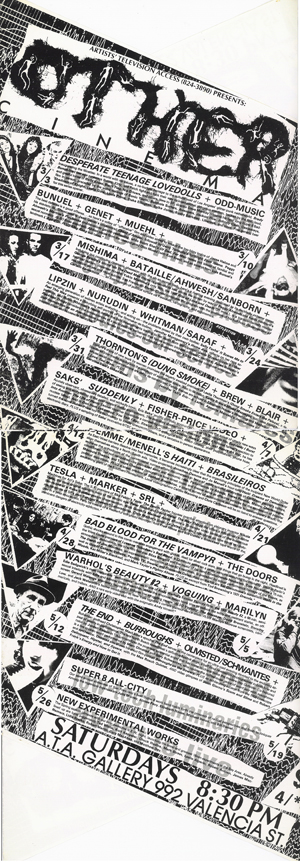
Other Cinema calendar, March 3-May 26, 1990.
Courtesy of Steve Polta and San Francisco Cinematheque.
SP: What did they do?
CB: There was an arm for the El Salvador solidarity movement in Northern California. There was probably one in every big city, L.A. too. Thereʼd be a propaganda arm–education and outreach–to organize and send money down there. There are millions of Salvadorans in the Bay Area. I donʼt know where the prints were made but they distributed them. And I actually worked with them a little bit, helped them clean up their splices and stuff. We did a big show once at the Victoria Theater, a benefit for people of El Salvador, revolutionaries–
SP: And what was your role in that show?
CB: I programmed it. It was a big show, with people sitting in fuckinʼ straight up theater seats, big screen, 16mm projection. There were probably two or three movies on that program, maybe four, with leader between them. I had to get the prints and put ʻem on the reel and blah blah blah.
SP: Were you living and working here at Artists’ Television Access [4] around this time?
CB: I probably was, because I moved here in ʼ86.
Hereʼs an example of the kind of thing Jeffrey Skoller and I would do around that time. We’d show Johnny Guitar [Nicholas Ray, 1954] and another Western on 16mm. Three shows in one night. It was part of the ARE [ARE was another San Francisco-based exhibition venue] thing: “Psycho Western.”
SP: What year was this? You showed it three times?
CB: Insane. It was almost more of a rep house kind of thing. It wasnʼt this fine art film shorts thing weʼre doing now.
SP: This seems more like an auteur program.
CB: Yeah, we did auteur. Jeffrey definitely has that auteur thing.
SP: What was your relationship with him then?
CB: Oh, just spiritual comrades. He was a good friend, roommate, and pal. A very dedicated maker and student of cinema.
SP: When you put these ARE programs together with Jeffrey, did you have the idea that you’d be doing this for a certain length of time?
CB: Well, no one could see beyond that. Itʼs a big hassle, once there are other things going on. Who wants to waste a lot of time doing this, writing this out, spending their own money–
SP: But youʼve been doing it for ages.
CB: Thatʼs ok: I have the masochism of the margins.
SP: What do you mean?
CB: Masochism of the margins means, you gotta take a lot of pain. If you were just [pause] totally averse to pain you wouldnʼt be in this part of the art world. But thereʼs a frisson with the tension and the deprivation–thereʼs a certain kind of excitement that comes out of it, living marginally, and if you totally went straight and just rented some hall and something from a distributor and put it all together–whatʼs the point? It might be a good show but it wouldnʼt be exciting. You wouldnʼt be taking any risk, or doing anything [pause] new. To do something thatʼs never been done–Other!–something new or alternative, then it becomes dangerous! And you have to suffer because of it. Thatʼs the masochism of the margins.
The term was first introduced to me by Steve Fagin. Itʼs not a new idea, but he nailed it right there; I recognized it immediately. It’s not the same as being poor and marginalized. Itʼs a choice. Iʼm totally middle class; my brothers are quite well off. I can’t say that I’ve always been [pause] victimized.
SP: Where did that attitude come from? When you were a beatnik in high school?
CB: I donʼt know what it was. I was the youngest child–maybe that had something to do with it.
SP: I thought the oldest child was usually the weird one.
CB: No, the oldest takes after the father. The youngest one gets the crap beat of out of him. But maybe the Viet Nam war made a bigger difference on me.
SP: Why? Tell me about that.
CB: It totally changed my life! A lot of the arty films that were really meaningful to me were anti-war films. But I always merged it together. I never separated pop and subculture from political activism. They were always married in my mind.
Why do I do this? That’s a bottomless question. I could list ninety-nine reasons: Because I enjoy it personally, itʼs a great social thing, I get aesthetic satisfaction out of it. Itʼs meaningful, itʼs political engaging, itʼs a community thing. All these things sound cliché but thereʼs no secret. Itʼs about taking a more active role. I donʼt think this will be any surprise to [future generations]. Itʼs about engaging with the present moment.
One of the best shows I put on in my entire life was at a place on 24th Street, near Ocho Loco [a performance venue located on 24th Street in San Francisco, at Potrero]. It was like a cabaret. People didnʼt sit in a long rectangular room; they sat the other way–i.e. the short throw–and there was a band right there: Five Year Plan. They were really good. They put the drummer up front. I remember some old wave kind of guy, going “no no–shut the drummer down, put him in the back,” but no no no, the idea was that it was a new wave kind of thing. It was more percussive, like The Slits. Itʼs more like [chanting] “Hiya pika puko yayo!” you know, more rambunctious and jazzy and filled with energy, so everyone was together when they watched it. It wasnʼt separated–we were watching the films and then we had the music.
SP: What year was this?
CB: Thatʼs gotta be between ʻ80 and ʻ84 if you can dig it. ʻ80, probably. Reagan. That show was, for me personally, an answer to your question about satisfaction or return or reward. Thatʼs where I would have wanted to be at the time, even if I wasnʼt programming it because it was absolutely at the front edge. It was absolutely what was happening, taking the people, the community–not just escapism, but having a good time–listening, dancing, drinking, picking up chicks and all that kind of stuff. But everybody was also so conscious. It was all about this engagement and smashing this asshole [Reagan], and it was good. It was, like, a little bit of rage in there, a little bit of anger and justice, you know, vengeance. A little bit of doing the right thing. Anyone can go see some stupid art film–thatʼs great and I donʼt put that down at all–but, to me, when there was a little more of a political sensibility, it seemed to have more juice to it, more bite, more danger, more excitement, and that was way cooler.
SP: You mean more of a community thing?
CB: Yeah, sure. Like the La Peña kind of thing or the Peopleʼs Cultural Center, or even the Valencia Tool and Die which I used to go to even before I started showing films. They would sometimes have films at these punk shows–it was all kind of pre-video. People would be marching around, thereʼd be films, and it was like, building an alternative.
SP: Tell me about the style and layout of your calendars.
CB: It’s whatever you want to call it: overdone, cramped, cluttered, whatever. A lot of small little gestures, typed, clip art. Itʼs not quite as messy as it used to be.
I never finished the whole story about Karl [Cohen]. He had this film called The Yippie Film, which is basically a collage of the Chicago National Convention [the 1968 Democratic National Convention], Abbie Hoffman and all those guys in there, and they nominated a pig for president.
SP: Like an actual barnyard pig?
CB: Yeah. They would always carry him around. It was very cute, and it was a brilliant stunt. The Yippie Film was a collage: it wasn’t only stuff from the political realm, from the streets, documentary material, newsreel verité footage, etc. It also mixed in all these old pie throwing things. It was just kind of the thing I used to like, because it had humor and was playful and was cut up and had good energy. Very early on, that kind of thing exerted a certain influence on me: the idea that you could make a political film and it could be a funny ironic surreal collage.
Around that time I was working at the Viz club, later called The Independent, and also called the Dog Saloon.
SP: Kennel Club. It was called the Justice League when I used to work there. [5] What were you doing at the Viz?
CB: I ran visuals there, films. Light shows. One or two projectors. Nothing like the Trocodero. [6]
SP: Where did you find the stuff that you showed?
CB: Early on I would collect material from lists. Not only the rental lists, but also the “to buy” lists. You could buy a Super 8 film, like a Blackhawk, and own it, and I still do [own the films], or you could buy these things which were second hands, or dupes, from other collectors: a clip from a part of a movie, for example. Every case is different.
SP: And you were pretty obsessed with this kind of collecting?
CB: I liked that part of it, yeah.
[…]

Other Cinema calendar, September 4-December 18, 1993.
Courtesy of Steve Polta and San Francisco Cinematheque.
SP: What was your relationship with Steve Anker [Artistic Director of the San Francisco Cinematheque] then?
CB: He liked my fliers. Occasionally he paid me to do one.
SP: How much did he pay you?
CB: I donʼt know. $20. Big deal. It was just more that he liked my style, thatʼs all.
SP: So where would a flier like this be? Were they on telephone poles around?
CB: Yeah. But I donʼt put anything on telephone poles anymore. Theyʼre torn down in such a short period of time.
Do you remember the 20th anniversary of the Cinematheque? For some reason I was called–maybe it was five or six years ago–asking, “Do you have any anecdotes?”
SP: Who called you? Anker? Kathy [Geritz, film programmer at Pacific Film Archive]?
CB: No, no. Somebody writing for the press, like Dennis Harvey or Johnny Ray Huston: “Weʼre just trying to write this story. Do you have any anecdotes about Cinematheque? Because we know youʼre this film guy in town.”
SP: And what was the story?
CB: Basically, it about was the Material Action Films [Materialaktionsfilme, Otto Muehl, 1970] screening. I was the projectionist that night, working above the door. Thatʼs where the projector was. A lot of these little storefronts in the Mission have a door that recedes and above it thereʼs a platform or a mezzanine: itʼs like a shelf. There are no rooms. Itʼs open: itʼs where grocers store their shit.
SP: So were you working for Cinematheque? Was that a regular thing for you?
CB: I might have been on their late night show. Anyway, the upshot is–have you ever seen Muehl’s Material Action Films? The last one, or the second to last, has a woman getting penetrated by a duck–or is it a goose? Well, itʼs hard to say what happened, but shortly after that scene, all the power went out. And that was the end of the show, cuz no one knew where the fuse box was. I’ve always thought that someone saw that scene and–I think the gooseʼs, or the swanʼs head gets cut off, and that that the person was probably upset.
SP: Thatʼs the end of the story?
CB: I have nothing to add. Itʼs a good anecdote, though. Everyone was plunged into total darkness. It was packed! Packed! Take my word for it. It was really hot in there.
SP: Like how many people? 100?
CB: Yeah! Well, 100 would be a little high to fit in a storefront. It was comparable to the size of the ATA theatre space. Iʼd say about 80.
SP: Do you think 100 people would come to see Otto Muehl now?
CB: Good question. I wouldnʼt show Otto Muehl now. Not because I donʼt like him. It just seems like he’s already been covered. If people want to find out about Muehl they can probably find his work on video somewhere. But Otto Muehl is still good. It wasn’t just a flavor of the month thing. It seems to me that was more of a culture of underground cinema kind of thing.
SP: You mean back then?
CB: Yeah. More about something rare and obscure: “Oh yeah—the material actions films! Iʼve heard so much about that…” There was a mystique to it. All this stuff! People donʼt seem to care anymore. Thereʼs so much access, so much information already out, so many things to do with our time, and so much competition. How can you get excited? Like I say–I had to go see these movies. When I was at Davis I saw five movies in one day. I would just have to go.
SP: Letʼs get back to what was happening then.
CB: Itʼs slightly over my head to draw any super big generalizations. Iʼm just talking about my impressions. And my impression is that there was more of an attraction back then. I always end up watching films anyway. But the need to have to see something–I never even go to a theatre now. It just seems like a preposterous old-fashioned idea to me.
SP: But youʼve got people coming out to see your shows every week.
CB: Donʼt you see? That has so much more juice to it. Thereʼs much more excitement and energy involved: seeing somebody doing live performance or a lot of short things, having an idea around it rather than just kicking back and watching a movie. It has to do with being in the contemporary moment. Otto Muehl is great, but his work is from a certain period. It seems more historical.
SP: But back then, it didnʼt seem that way?
CB: Yeah–maybe not. It seemed more contemporary.
SP: Like it had more relevance?
CB: Yeah yeah yeah.
SP: How do you know whatʼs relevant now? Where do you get your ideas from? For instance, how do you know when itʼs time to show something retro now?
CB: If I gave you an answer it would sound like I have a system but thatʼs really not the case. There are fourteen programs on each calendar, and there are conditions that are in motion. There are things happening in the world, that appear in the newspaper, and there are things that happen locally. For example, [monthly cyclist activist event] Critical Mass is a big thing now; everybody knows that thereʼs energy around bikes, and other green issues. Then there are things that are happening in the art world, and there are things that happen in the world of ideas, like books being published. That has always been a big influence on me: new sorts of arguments that come out of books. A lot of times I get show ideas from books—I canʼt read the books but Iʼd like to see a film show around the issues they raise.
SP: Whatʼs an example?
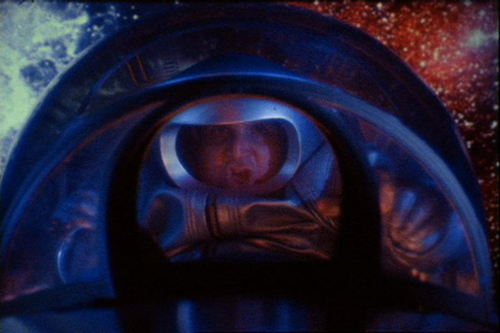
Mock Up on Mu / Craig Baldwin
CB: [Pauses.] Well, in a way Iʼm making a film [Mock Up on Mu] that kinda came out of a book, Sex and Rockets [Sex and Rockets: The Occult World of Jack Parsons by John Carter]. Thatʼs not exactly programming but when I finish the film itʼll get programmed. Or, Noam Chomsky could come out with a new book, and maybe thereʼs a new documentary about him. I donʼt have time to read the Chomsky book, but heʼs at the front lines. All eyes are on him: heʼs still got something to say. Or it may be a theory, whatever. Anything. Sexuality. Systems science. Graffiti. Anything that has a certain place in the world of ideas. If you look at the last two or three seasons of Other Cinema youʼll see thereʼs always a book launch on the calendar. I like very much what Modern Times [a bookstore on Valencia Street in San Francisco] does.
In other words, do like the writer. But if you go to a book talk, you end up listening to someone read. How boring! But to do something like a book talk, where you donʼt read–maybe a couple pages, sure–but the point is to include a motion picture component. It can be in slide show form, PowerPoint, spoken word, reading, and/or performance even. Together these things add up to a whole evening, in which an idea can be considered several different ways.
A perfect example would be the Sam Green show [December 8, 2007]. Thatʼs going to be a very exciting show. Take my word for it. But if you look at it on the calendar, youʼll say, “I donʼt even know whatʼs going on down there.” Theyʼre just going to talk through ideas. But I guarantee that show will sell out, because Samʼs an interesting maker. Or maybe he isnʼt, but people want to find out.
Thatʼs where I want to take it now: towards ideas. Itʼs more about creating a platform for ideas, which can be worked through in many different ways. If you go to some cushy theatre and just sit there for two hours, thatʼs fine. But it doesnʼt have the same currency, the same dialog.
Another example is what Greta [Snider] did [November 11, 2006], [7] with the 3-D. That was a pretty sophisticated idea of programming. Itʼs a long ways from throwing an hour long documentary on the screen, like news footage, a bunch of people raising their fists. Thatʼs great, but to actually present something with subjectivity, like with slides–itʼs not even movies now, just slides–while someone talks over them. Donʼt you see how discursive that is? Itʼs more of a dialog; it involves answering questions, and more direct responsibility, accountability, and presence. It has more of a “being there” quality.
Itʼs also a total microcinema idea. As opposed to a huge theatre, like The Castro [Theatre, in San Francisco]–you can put 500 people in there–where everybodyʼs watching Clark Gable in Gone with the Wind, a great film, no argument, but Iʼm not interested in that. Itʼs worthless as an experience. But to bring people together, to create a platform for the sharing of ideas, that, to me, goes beyond cinema. Thatʼs breaking though, you know? Thatʼs bringing it back to books. Except a book is not a public thing, unfortunately. You canʼt have a guy out there reading his book–itʼs preposterous. But you can have a guy or girl up there, and they can read a little bit and then talk and show. Slide shows are my favorite.
SP: Why? Whatʼs so great about slide shows?
CB: Because of the language. Again, this is more my style and preference. The combination of language and images–thatʼs what I like. Thereʼs a million galleries around town that have beautiful images and pictures in them, but itʼs not my thing. My interests in so-called “art,” are really not about decoration, or visual beauty, whatever that is. Iʼm very skeptical about those terms.
But these activities, these environments weʼve created, get exciting when there can be a challenging exchange of ideas. There may be contestation, criticism, dialectical give and take. That, to me, is cutting edge. The most exciting thing is developing and challenging ideas about new art. Film is so much more capable of that than painting, if you ask me. But now you can create a show thatʼs as creatively challenging as making a movie, because you’re still putting components together.
Take the show last night [September 29, 2007]–it was awesome, even though there wasnʼt a lot of language involved. I didnʼt put that show together [8] but it’s typical of a show I could totally, unequivocally, get behind: different people working together, some of the same genres, different instrumentation, everybody had their own style, different films but they were also by [animator Ray] Harryhausen. There was a million different ways you could look at it and everything was a new experience yet it totally held together.
For me it was great because there was this wildness yet there was also a circling back to film history–Harryhausen, early childrenʼs animation–and these stories, with all their cultural richness. There was just layer after layer and depth depth depth depth depth. You saw so much just in the films themselves, and with the music on top, you say, “Yeah! Now weʼre really kickinʼ it!” Itʼs not just retrieval of old funky movies for archeological purposes–that wouldnʼt have held either. The movies are unwatchable on their own. Theyʼre preposterously mediocre. But the new stuff, with the music, that became something exciting.
Ultimately, thatʼs what Iʼm going for: not just creating a comfortable thing where people can kick back with a tall cup of coffee and savor the moment. Thatʼs not my idea. It’s really about setting up a dynamic relationship between audience and musician, artist/presenter, talker, explainer, interpreter, benshee, etc. The benshee is a brilliant idea; give Konrad credit for that. [9] I share in that idea: old films and new music. Old films are great, but it can’t be pure retrieval from the archive: itʼs about putting something new with it.
1. ATA is also the home venue of Baldwinʼs Other Cinema. For more on Other Cinema, an “ongoing series of unusual and experimental film,” see http://www.othercinema.com/
2. “Industrials Amok” is a recurring program of industrial and educational films presented at Other Cinema.
3. Em Gee films is an independent distributor of short subject films, located in Reseda, CA.
4. Artistsʼ Television Access was originally located at 222 Eighth Street in San Francisco. Its destruction by fire circa 1982 led to its relocation to 992 Valencia Street and precipitated Baldwinʼs involvement.
5. The interviewer worked at this venue projecting film video for a few months in 1998.
6. Baldwin and the interviewer worked together doing film projection light shows at The Trocadero nightclub for ten months circa 1997.
7. This program presented short personal documentary and essayistic works by combining spoken first person narration with projected 3-D slide imagery.
8. This program, guest curated by Christine Metropoulos, paired live music created by local experimental music creators with animated childrenʼs fairytale films. .
9. Several years prior to this interview, San Francisco-based curator Konrad Steiner began organizing occasional “Neo-Benshee” events, in which writers and poets would compose text to be read over pre-existing films. This is modeled on the Japanese tradition of supplementing silent-era films with live spoken narration. The speaker in this tradition is known as a benshee. Baldwinʼs Other Cinema has hosted Steinerʼs events on several occasions.
ABOUT THE AUTHOR
Steve Polta is a filmmaker, sound artist, occasional writer, and occasional historian living in the San Francisco Bay Area. He is also the Archivist and Artistic Director of San Francisco Cinematheque and a once-in-a-while radio DJ on KALX Berkeley. He holds a BA in Film Studies from UC Berkeley, an MFA in Filmmaking from the San Francisco Art Institute, and will soon receive a Masters of Library and Information Science from San Jose State University. He makes his living as a taxi driver in San Francisco.
INCITE Journal of Experimental Media
Manifest
